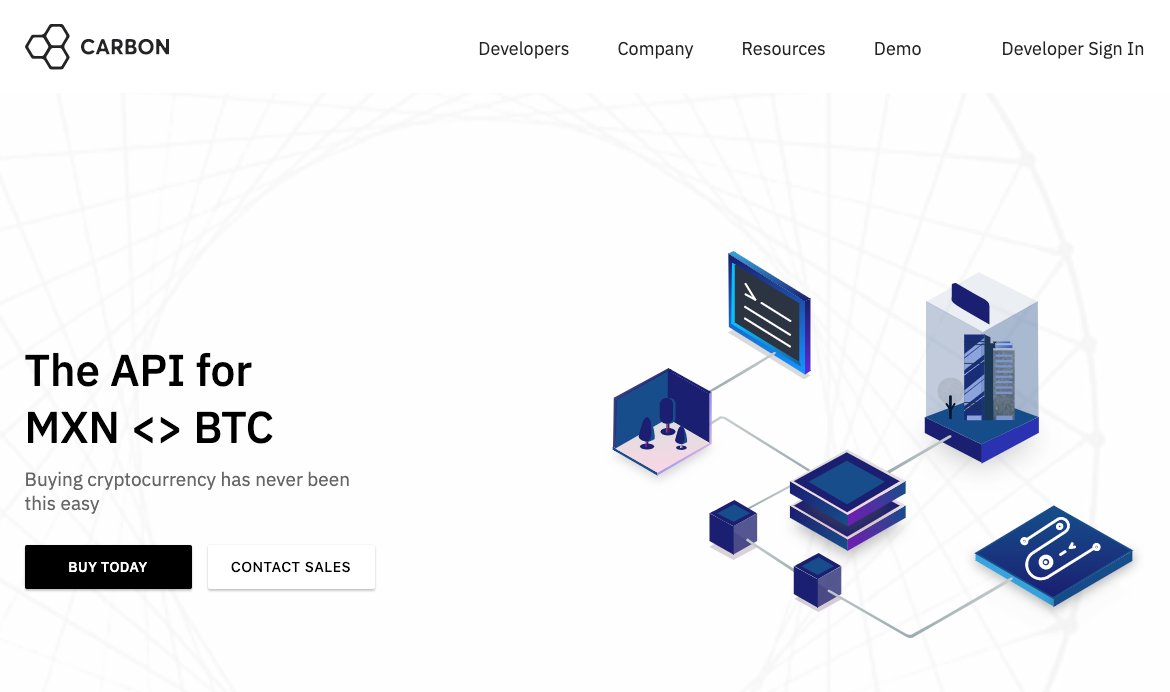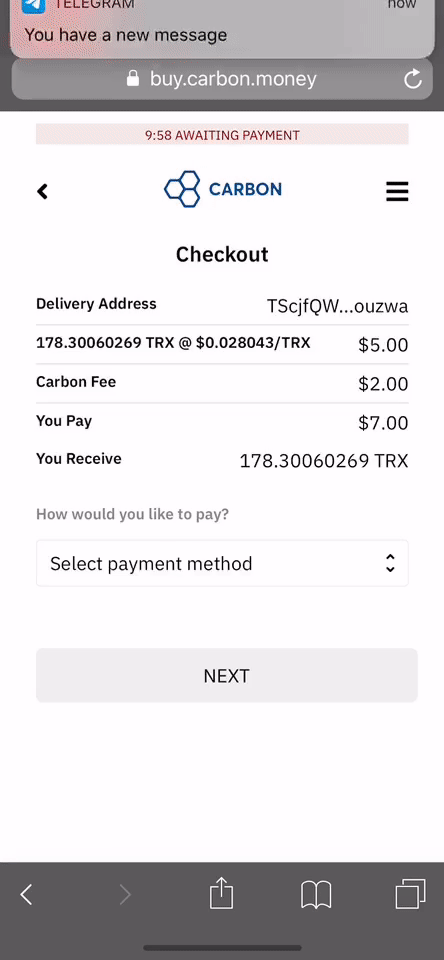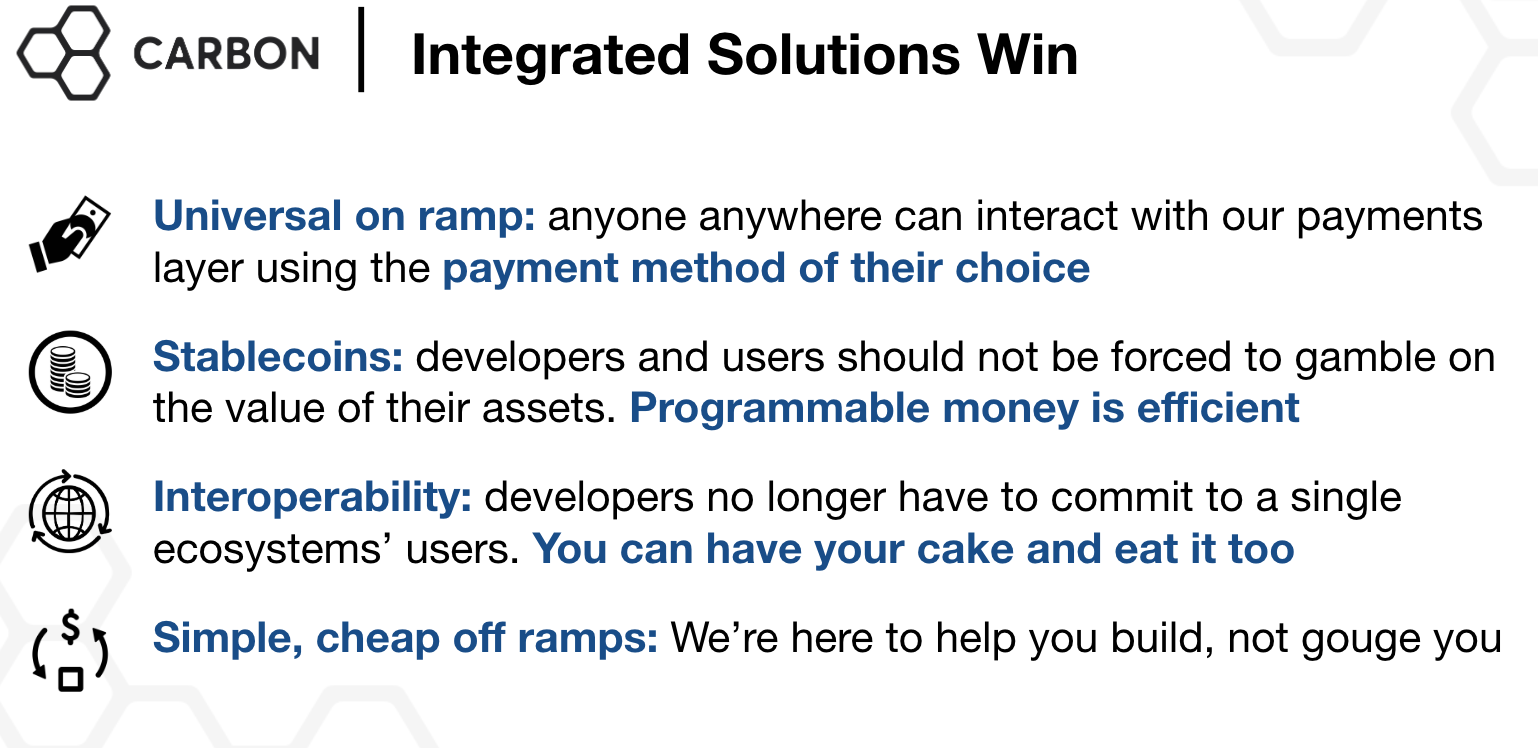Nick Pai, from Carbon team, told us how they built Stripe for Crypto and how they deal with regulatory compliance when building Fiber.
Hello! What’s your background, and what are you working on?
Hello all, I’m Nick, Lead Software Engineer at Carbon and Co-founder of Katechon, our capital markets software stack.
I began programming in high school, studied Computer Science and Philosophy at Princeton University, and used Princeton’s computing cluster to mine cryptocurrencies in 2014-15. After graduation, I built software infrastructure at Barclays Capital for executing corporate-bond portfolio arbitrage trades, which involved identifying arb opportunities, executing the trades, and analyzing trades after the fact. I found building new software at a large investment bank to be difficult because I was working with legacy technologies and slow-moving bureaucracy. Nonetheless, our admittedly simple portfolio trading software was ahead of the curve because other Wall Street firms were running into similar development problems.
In 2017, Cryptocurrencies again became a passion of mine as I identified the surging crypto markets as possessing the rare combination of sufficiently high volume, integration with state of the art software, and massive inefficiencies. It was a trader’s dream market, and I sympathized strongly with Carbon’s long term plans of lowering barriers to entry for crypto markets.
Fiber is our modular fiat on/off ramp that allows users to buy cryptocurrencies within minutes via user-friendly and low-fee payment methods, significantly improving the status quo on-boarding experience for blockchain applications. Previously, we found the process of purchasing cryptocurrencies too time-consuming for normal users and the few existing credit card on-ramps also had high fees and failure rates, so we ultimately set out to make the purchasing process more intuitive for the mainstream. Wherever the Fiber API is integrated into our partners’ websites or applications, users can quickly purchase various cryptocurrencies including small-cap tokens via Visa, MasterCard, American Express, Apple Pay, with more payment rails and fiat off-ramps coming soon. They can pay in over 180 fiat currencies from over 100 currently supported countries. A process that used to take around 30 minutes or more can happen now in just a few clicks. For partners, integration is easy, and we handle all chargeback risk with our robust anti-fraud tools.

What’s Carbon Fiber backstory?
During the fall of 2018, a few team members had a call with a well-known decentralized exchange product manager, who had expressed interest in integrating CUSD’s fiat on/off-ramp into the exchange’s website. The feature request led to a spark of inspiration to build an API which we named “Fiber,” complementary to the company’s name, of course, Carbon. We knew this was only the beginning. We set out to support more popular payment rails, such as credit and debits cards, to enable fast and low-fee purchases of various cryptocurrencies in addition to CUSD. Internally, we referred to the initiative as the “Stripe for Crypto.”
We put significant energy into ensuring our regulatory compliance when building Fiber. While we had already supported ACH and Wire rails for CUSD domestically, we focused our efforts on supporting additional payment methods and cryptocurrencies for international users due to the United States’ particularly strict regulatory standards. While our international payments stack supports widespread global coverage, supporting similar functionality in the U.S. in as many states as possible is one of our top priorities at the moment.
Fiber goes hand-in-hand with our philosophy of reducing friction so that value can flow freely without wasted time.

The main challenge when developing on a blockchain is the lack of documentation, sound engineering principles, and immature communication channels. I won’t name names, but building on some of the “leading” blockchains feels like running repeatedly into a wall because the documentation is three months out of date (an eternity in crypto-time) and there are no official “support” groups for developers. It is like we’ve been given a set of legos to build with no instructions and no contacts to answer our questions. For example, we integrate with 30+ crypto exchanges, and some of them will “update their API’s” suddenly and without warning, causing our software pipelines to break temporarily. The tradeoff, of course, is that we have become battle-tested rather quickly. Our developers know how to look carefully at source code and piece together an integration solution, and we have developed software to minimize counterparty risk.
What’s your business model?
We take small, transparent fees on each transaction. At this stage, we are optimizing for growth instead of revenue, but we will continue to cut down on our cost basis as volume increases over time, which will, in turn, increase our margins. We are comfortable operating in the stablecoin space as a loss leader since we are more focused on payments, but we believe Fiber’s payment rails and overall UX combined with the high transaction throughput of CUSD powered by next-generation blockchains will make our stablecoins very intuitive to mainstream users and merchants who may not know or care that our solutions leverage blockchain technology in the backend for certain applications.

With regards to the target market, we operate the only fiat-backed stablecoins on EOS and TRON, which represent 93% of all dapp transaction volume. They have an $8 billion collective market cap. Under 5% of Americans own crypto, but over 80%+ have credit or debit cards. Our technology allows developers to 16x their total addressable market by making their dApp or crypto accepting business accessible to anyone who owns a credit or debit card.
CUSD will have a variety of user-friendly fiat on/off ramps, making it more appealing to mainstream users who can easily onboard in minutes without having prior experience using cryptocurrencies. We plan to support CUSD on Binance Chain within Fiber, our API for Fiat<>Crypto.
Wherever Fiber is integrated (including on the Carbon website), users can seamlessly purchase pre-minted CUSD and other cryptocurrencies with Visa and MasterCard, debit cards, Apple Pay, and soon PayPal, SEPA, UnionPay, and more with fiat off-ramps. Users can pay in 180+ fiat currencies.
We also have a capital markets team dedicated to liquidity management as well as market making for clients. We initiate crypto-transfers within seconds of users clicking the “purchase” button, enabling a smooth on-boarding experience.
What’s your position on the regulatory landscape today?
Cryptocurrencies are a new asset class and should not be subject to the same laws regulating other assets, but they are a complex asset class nonetheless, and any complex asset enables the possibility of fraud and dishonest behavior.
Regulating all cryptocurrencies uniformly would not make sense since some are used as low-friction investment vehicles while some are used purely as commodity tokens. For example, some regulations should be created to protect investors in the case where they invest in ventures via cryptocurrencies, but this should not apply to all tokens.
Moreover, there are many ways to interact with the same token, and oftentimes these methods should be regulated differently. For example, a private company running a digital currency exchange might conduct an initial offering for a commodity token. Does this constitute a securities offering? If so, then should the exchange or the token be regulated? Both?
Clearly, we have a long way to go on the crypto-regulation side, and like many emergent technologies, legal is left-behind to reign the product in. My biggest source of optimism here is simply that we are having these conversations, and you have to start somewhere.
What are your goals for the future?
Since we recently just released Fiber, we’ve been listening to feedback for the last few weeks and iterating on the product. Some longer-term goals we have are to expand coverage, specifically supporting the United States. Outside of those, we’re always looking into building redundancy for our payment stack and expanding our current payment rails including country-specific ones.
For the past few weeks since launch, we have been pushing the integration of Fiber into as many blockchain apps as possible and closely monitoring the user experience for any required fine-tuning. We hope to support fiat off-ramp functionality in the next couple of weeks. A project in our sights that may take a few months is to create an API for custody in order to abstract away complexities to make on-boarding for users easier.
What are your future thoughts for the DeFi market?
Based on our push to release Fiber, one aspect that we think is inevitable (and hope to reach first) is chipping away at friction. Our team looked at the process of buying crypto and realized how inefficient and time-consuming the process was for the user, inspiring Fiber. Even though our team has spent countless hours since last September building this passion project, we realize that there are countless other markets and institutions that are marred with friction.
We think Fiber is a step towards a future where there are no walls nor powerful gatekeepers. We personally value this as our company’s primary mission and are excited to see where the journey to eradicating friction goes, hopefully allowing value to flow freely between all systems.
